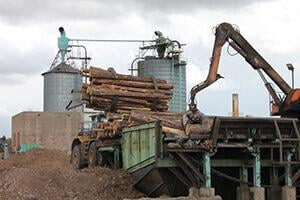By Alex Portal Black Hills Pioneer
NORTHERN HILLS — The local timber industry got some welcome news last week when a formal review of the findings from a critical general technical report (GTR) found flaws in the conclusion’s methodology.
In February 2021, the Rocky Mountain Research Station in Fort Collins, Colo., issued GTR-422, which forecasted a dire situation in the Black Hills National Forest, which led the U.S. Forest Service to slash its timber sales allotment in the coming years.
“We heard the talking point numerous times that the timber resources have been reduced by 50%, ergo you must reduce timber harvest by 50% and (the review) dispels that myth,” explained Ben Wudtke, executive director for the Black Hills Forest Resources Association (BHFRA).
After the GTR was released, the Forest Service announced a three-year reduction plan that dropped the allowable timber sales from 18.1 million cubic feet (CF) to 12.4 million CF, then to 9.1 million CF in 2022, and 8.86 million CF by 2023. That reduction has already directly affected the timber industry in the Black Hills with the closure of Rushmore Forest Products in Hill City in March 2021.
In November 2021, the BHFRA filed a formal request for correction of information against several claims found in the GTR through the Data Quality Act. That request was ultimately reviewed and denied by the Rocky Mountain Research Station in March of this year, so the association filed a request for reconsideration with an interagency review panel in April. That review panel was comprised of three timber and statistical modeling experts from the Bureau of Land Management, and one research forester from the Forest Service.
“Of the 7 claims, the panel finds that claims 1, 2 and 7 were substantiated as not adequately addressed in the initial response,” read the panel’s response letter.
“We didn’t feel that our initial request was given a fair evaluation, so we appealed that; and this not only affirms that it wasn’t given a fair evaluation, but it also goes a couple steps further and clears up some information about standing timber inventories on the Black Hills National Forest,” Wudtke said.
The review panel didn’t refute all the claims brought against the GTR, but it did walk back the conclusion that the timber volume had been reduced by 50% on the Black Hills; a particular point of contention for the BHFRA.
“The Reply (from the Rocky Mountain Research Station to the BHFRA’s request for correction) continues to disregard timber resources available for harvest outside the suited base and instead relies on a disclaimer to continue monitoring for mortality and growth rates instead of acknowledging other available timber resources or potential changes in suited base,” the panel’s letter states.
“We have long disagreed with that, and this response affirms that, and also goes on to point out that when you use a similar number of acres of Black Hills National Forest, the actual (timber volume) reduction is somewhere closer to 18%-20%,” Wudtke said.
Although the Forest Service has said it does not enact policy changes based on any one piece of data, its timber sale reduction plan aligns with the findings of the GTR, largely hinged on the now debunked timber volume assessment. Now that the basis for that recommendation has been formally acknowledged as flawed, the question remains whether it will affect how much timber sales the Forest Service will allow on the Black Hills.
This doesn’t necessarily mean timber sales will be increased.
“I don’t know what it means for the original GTR; that’s up for the Forest Service to figure out,” Wudtke said. “This does-in my mind-change the talking points of the report and the base that’s been used to advocate for timber harvest reductions on the Black Hills National Forest.”
The review panel’s letter outlined its conclusion, but the ultimate decision on what to do with that information is up to the Rocky Mountain Research Station.
“Upon consideration, I leave the choice of using a revision or addendum to address the corrective actions up to the RMRS (Rocky Mountain Research Station) Station Director,” read the Forest Service’s corrective action letter, issued in response to the panel’s findings by Cynthia West, the acting deputy chief of research and development with the Forest Service. “The corrective actions specified by the panel need to be addressed in a publicly available draft by December 15, 2022, through posting on a website, with the understanding that there will need to be additional time for editing and layout before a final document of the corrective actions will be posted.”
“We would encourage them to look at doing that in a more collaborative and communicative process than they did the original general technical report,” Wudtke said. “These issues that we raised under the data quality act, we raised in our original comments to the draft GTR, before they ever published a final (in February 2021), and it’s our hope that through more collaboration and more communication we can avoid going down this route in the future.”
